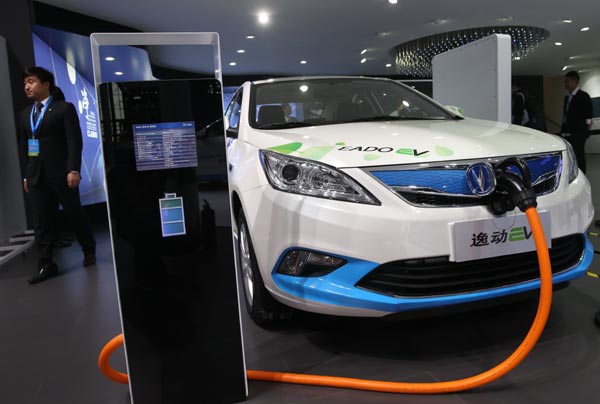Green cars can drive forward green economy
By Zhu Qiwen (China Daily) Updated: 2015-07-09 08:02
 |
|
A Changan electronic car, one of the domestic brands, on display at the Shanghai auto show. Domestic automakers unveiled 51 vehicles, nearly a half of the new-energy cars at the event. The sector is becoming extremely competitive in the China with foreign players snatching the lion's share of the market. [Photo/China Daily] |
The ongoing surge in China's production of new energy cars is more than welcome. Although the total number of green cars is far from enough to ensure a substantial change in China's energy consumption pattern anytime soon, its accelerated growth should give a huge boost to policymakers at home and abroad who are desperate to find ways to slow global warming and spur economic growth.
The latest statistics show that in the first half of this year, Chinese automakers produced 78,500 new energy vehicles, including pure electric and hybrid vehicles, a threefold surge over the same period last year.
Compared with the country's annual production of more than 20 million vehicles, it is more than obvious that the production of new energy cares is still of little significance to the balance sheets of most domestic automakers.
Yet, contrasting sharply with the meager growth rate of 2.11 percent for the country's auto sales in the first five months, a considerable slowdown from the 9 percent year-on-year growth rate in 2014, the triple-digit growth of green cars will probably persuade more domestic automakers to reconsider their investment plans.
And if all major Chinese automakers join in the competition for an advantageous position in China's market for new energy cars, which is expected to become the world's largest, surpassing that of the United States, the growth in green cars will be further accelerated, which will make a real difference.
After more than three decades of double-digit growth, the Chinese economy, the world's second-largest, has slowed considerably in recent years to accommodate necessary economic restructuring. But it is expected that the rapid greening of the Chinese auto industry will spearhead the country's efforts to pursue more energy efficient and environmentally friendly economic growth.
The Chinese government has been trying hard to put more new energy vehicles on road, and policymakers have done a lot to promote the use of green cars. In March, the Ministry of Transport set a target of 300,000 new energy commercial vehicles on China's roads by 2020, including 200,000 new energy buses and 100,000 new energy taxis and delivery vehicles.
Undoubtedly, such efforts are closely related to the country's ambitious plan to reduce carbon emissions and develop a green economy, which was recently submitted to the Secretariat of the UN Framework Convention on Climate Change. According to the plan, China aims to effectively curb carbon dioxide emissions by 2030, when it intends to have cut such emissions per unit of GDP by 60 to 65 percent from 2005 levels.
But as a developing country with the world's largest population, it is hard to imagine that China, which is also one of the world's largest greenhouse gas emitters, could one day lead the world in going green. But if the success of green cars in China can prove the possibility for it to nurture a new competitive edge through environmentally friendly growth, it provides a valuable example for global policymakers who are eager to figure out viable solutions to bend the curve of climate change.
The current surge in the production of green cars in China is a good sign that enhanced government support is convincing more and more Chinese consumers to accept new energy cars, although difficulties remain for early adopters.
There is no guarantee that the road ahead will not turn bumpy from time to time for new energy cars. However, the great potential of green cars justifies more government efforts to build on the present momentum of growth to speed up the mass consumption of green cars.
The author is a senior writer with China Daily. zhuqiwen@chinadaily.com.cn

I’ve lived in China for quite a considerable time including my graduate school years, travelled and worked in a few cities and still choose my destination taking into consideration the density of smog or PM2.5 particulate matter in the region.











